WHERE DO I BEGIN? Advice From Eastern European Master Teachers
One of the most frequent questions I hear from parents and classroom teachers who want to start an art program for their students is, “How do I know where to begin?” They worry about offering art lessons that are either to easy or too difficult.
The question is really part of a larger, more basic question:
What sequence should we follow in an art program?
If we have a picture of the whole sequence to be followed when learning something, it’s much easier to find our beginning place.
Take elementary math as a example. We need to know how to count before we learn addition. We need to know addition and subtraction before we can learn about multiplication. Every discipline has its building blocks.
A piano student has to learn the names of notes. fingering, arpeggios, chords, and scales. It is only after hours of practice that the piano student stops merely getting the notes “right,” and begins to move us with the performance.
Art classes have building blocks too. These building blocks were made most clear to me a few years ago when I visited master teachers in Ukraine. I had been invited to visit classes at the Artistic Theatrical College in Odessa, Ukraine, and the head instructor proudly showed me steps his students had to follow in learning to draw and paint.
Before they were allowed to use their art expressively, they had to master the building blocks.
-
They began by drawing and shading simple geometric shapes and draped fabric forms
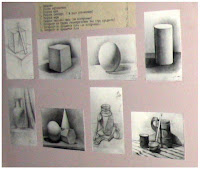
-
Then they drew and shaded architectural forms.

-
Finally, they drew plaster casts of parts of the human body, and even these followed a strict progression:
They mastered drawing eyes, noses, and ears before they drew a face.
They mastered hands, feet, limbs and torsos before they could drew a figure.
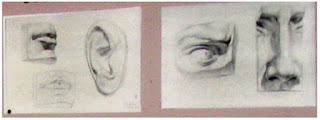
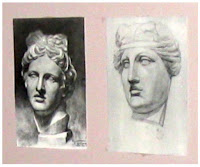
They mastered pencil drawing and shading before they used paint, and even then the painting had to be photographically representational. By the end of the year, classroom walls were covered with examples of students’ work:
-
All of it was copy work.
-
None of it was expressive.
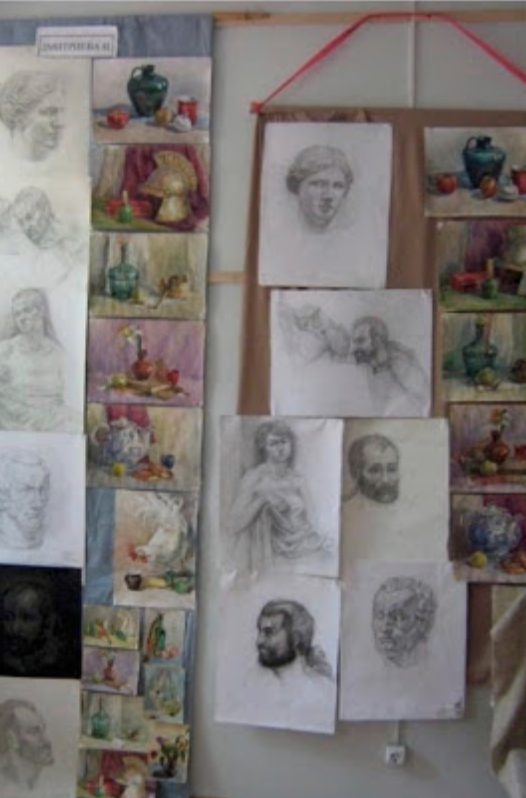
Only after all of this copy work, were students finally allowed - and expected - to be creative, expressive, and original. And what dramatic work they created!
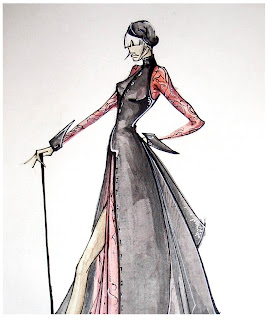
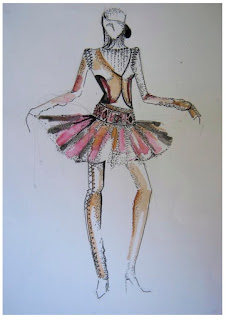
What does this mean for art students in elementary and middle school?
What building blocks do we need?
In the first stage of work, students need to
-
Learn to see, and to draw what they see. This is best learned by imitation: following someone else as they draw.
-
Learn to use the media. They need to learn to control watercolor, blend pastels, and use degrees of value.
-
At this point, having small opportunities for expressiveness is helpful to give student ownership of their work.
In the second stage, students need to
-
Practice drawing increasingly difficult subjects.
-
Take increasing roles in following artistic principles, like creating emphasis, arranging a composition, and creating motifs.
It is only in the later stages of learning that students should be expected to deal with style: with matters like impressionism, Art Deco, Pointillism etc. Asking a beginning student to imitate Van Gogh may be a way of introducing the student to Van Gogh, but it may also be a setup for frustration.
Kids themselves seem to know this sequence. They WANT their horse to look like a horse, and if they cannot make that happen, they are likely get frustrated and conclude they just aren’t “artistic.” If you are wondering where to start your student with art lessons, think of where they might be on this simple scale as you set up your curriculum.
So where should you begin with ArtAchieve art lessons?
Try the free Czech Cat lesson to see how many challenges it offers, and how your own skills match up.
If you're ready for a bigger challenge, try a lesson in Level II. It's an easy way to see where your skill level is, and then you'll know where to dive in for projects that challenge you to learn new skills.
One of the most frequent questions I hear from parents and classroom teachers who want to start an art program for their students is, “How do I know where to begin?” They worry about offering art lessons that are either to easy or too difficult.
The question is really part of a larger, more basic question:
What sequence should we follow in an art program?
If we have a picture of the whole sequence to be followed when learning something, it’s much easier to find our beginning place.
Take elementary math as a example. We need to know how to count before we learn addition. We need to know addition and subtraction before we can learn about multiplication. Every discipline has its building blocks.
A piano student has to learn the names of notes. fingering, arpeggios, chords, and scales. It is only after hours of practice that the piano student stops merely getting the notes “right,” and begins to move us with the performance.
Art classes have building blocks too. These building blocks were made most clear to me a few years ago when I visited master teachers in Ukraine. I had been invited to visit classes at the Artistic Theatrical College in Odessa, Ukraine, and the head instructor proudly showed me steps his students had to follow in learning to draw and paint.
Before they were allowed to use their art expressively, they had to master the building blocks.
-
They began by drawing and shading simple geometric shapes and draped fabric forms

-
Then they drew and shaded architectural forms.

-
Finally, they drew plaster casts of parts of the human body, and even these followed a strict progression:
They mastered drawing eyes, noses, and ears before they drew a face.
They mastered hands, feet, limbs and torsos before they could drew a figure.


They mastered pencil drawing and shading before they used paint, and even then the painting had to be photographically representational. By the end of the year, classroom walls were covered with examples of students’ work:
-
All of it was copy work.
-
None of it was expressive.

Only after all of this copy work, were students finally allowed - and expected - to be creative, expressive, and original. And what dramatic work they created!


What does this mean for art students in elementary and middle school?
What building blocks do we need?
In the first stage of work, students need to
-
Learn to see, and to draw what they see. This is best learned by imitation: following someone else as they draw.
-
Learn to use the media. They need to learn to control watercolor, blend pastels, and use degrees of value.
-
At this point, having small opportunities for expressiveness is helpful to give student ownership of their work.
In the second stage, students need to
-
Practice drawing increasingly difficult subjects.
-
Take increasing roles in following artistic principles, like creating emphasis, arranging a composition, and creating motifs.
It is only in the later stages of learning that students should be expected to deal with style: with matters like impressionism, Art Deco, Pointillism etc. Asking a beginning student to imitate Van Gogh may be a way of introducing the student to Van Gogh, but it may also be a setup for frustration.
Kids themselves seem to know this sequence. They WANT their horse to look like a horse, and if they cannot make that happen, they are likely get frustrated and conclude they just aren’t “artistic.” If you are wondering where to start your student with art lessons, think of where they might be on this simple scale as you set up your curriculum.
So where should you begin with ArtAchieve art lessons?
Try the free Czech Cat lesson to see how many challenges it offers, and how your own skills match up.
If you're ready for a bigger challenge, try a lesson in Level II. It's an easy way to see where your skill level is, and then you'll know where to dive in for projects that challenge you to learn new skills.
One of the most frequent questions I hear from parents and classroom teachers who want to start an art program for their students is, “How do I know where to begin?” They worry about offering art lessons that are either to easy or too difficult.
The question is really part of a larger, more basic question:
What sequence should we follow in an art program?
If we have a picture of the whole sequence to be followed when learning something, it’s much easier to find our beginning place.
Take elementary math as a example. We need to know how to count before we learn addition. We need to know addition and subtraction before we can learn about multiplication. Every discipline has its building blocks.
A piano student has to learn the names of notes. fingering, arpeggios, chords, and scales. It is only after hours of practice that the piano student stops merely getting the notes “right,” and begins to move us with the performance.
Art classes have building blocks too. These building blocks were made most clear to me a few years ago when I visited master teachers in Ukraine. I had been invited to visit classes at the Artistic Theatrical College in Odessa, Ukraine, and the head instructor proudly showed me steps his students had to follow in learning to draw and paint.
Before they were allowed to use their art expressively, they had to master the building blocks.
-
They began by drawing and shading simple geometric shapes and draped fabric forms

-
Then they drew and shaded architectural forms.

-
Finally, they drew plaster casts of parts of the human body, and even these followed a strict progression:
They mastered drawing eyes, noses, and ears before they drew a face.
They mastered hands, feet, limbs and torsos before they could drew a figure.


They mastered pencil drawing and shading before they used paint, and even then the painting had to be photographically representational. By the end of the year, classroom walls were covered with examples of students’ work:
-
All of it was copy work.
-
None of it was expressive.

Only after all of this copy work, were students finally allowed - and expected - to be creative, expressive, and original. And what dramatic work they created!


What does this mean for art students in elementary and middle school?
What building blocks do we need?
In the first stage of work, students need to
-
Learn to see, and to draw what they see. This is best learned by imitation: following someone else as they draw.
-
Learn to use the media. They need to learn to control watercolor, blend pastels, and use degrees of value.
-
At this point, having small opportunities for expressiveness is helpful to give student ownership of their work.
In the second stage, students need to
-
Practice drawing increasingly difficult subjects.
-
Take increasing roles in following artistic principles, like creating emphasis, arranging a composition, and creating motifs.
It is only in the later stages of learning that students should be expected to deal with style: with matters like impressionism, Art Deco, Pointillism etc. Asking a beginning student to imitate Van Gogh may be a way of introducing the student to Van Gogh, but it may also be a setup for frustration.
Kids themselves seem to know this sequence. They WANT their horse to look like a horse, and if they cannot make that happen, they are likely get frustrated and conclude they just aren’t “artistic.” If you are wondering where to start your student with art lessons, think of where they might be on this simple scale as you set up your curriculum.
So where should you begin with ArtAchieve art lessons?
Try the free Czech Cat lesson to see how many challenges it offers, and how your own skills match up.
If you're ready for a bigger challenge, try a lesson in Level II. It's an easy way to see where your skill level is, and then you'll know where to dive in for projects that challenge you to learn new skills.








